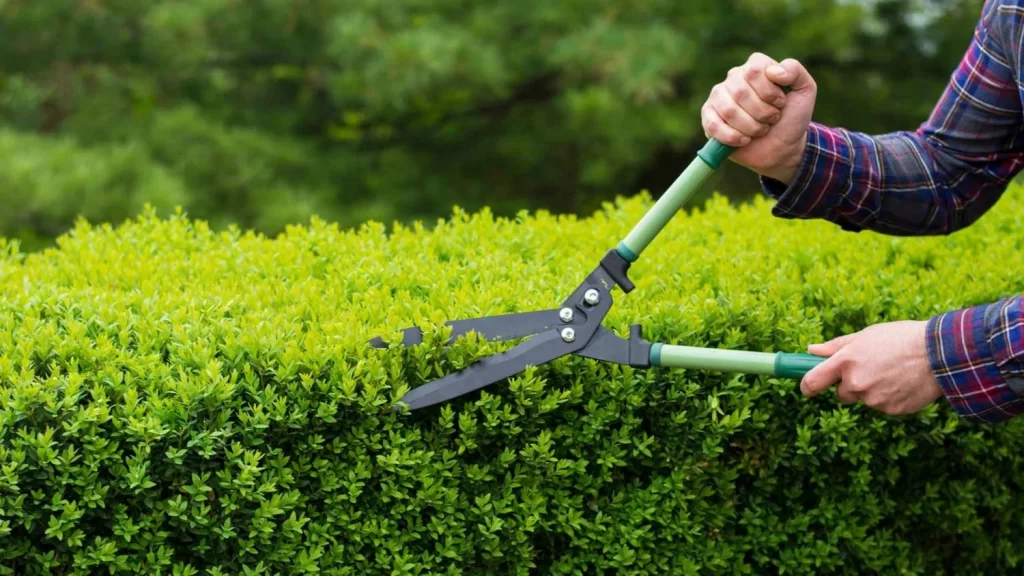Hedges are an integral part of many gardens and landscapes, offering privacy, structure, and aesthetic appeal. However, to ensure that hedges continue to thrive and remain healthy, regular trimming is essential. While it may seem like a purely cosmetic task, hedge trimming goes beyond just maintaining a tidy appearance. When done correctly and consistently, trimming can have numerous benefits for the overall health of your plants, enhancing their growth, longevity, and vitality. In this article, we’ll explore the many advantages of regular hedge trimming and why it’s essential for maintaining healthy plants in your garden.
1. Encourages Healthy Growth
One of the primary benefits of regular hedge trimming is that it promotes healthy, robust growth. When hedges are trimmed correctly, the plants focus their energy on growing stronger and healthier. Removing dead or overgrown branches allows the plant to redirect its resources towards the development of new growth, encouraging a dense and vibrant hedge.
How Trimming Encourages Healthy Growth:
- Prevents Overgrowth: Without trimming, hedges can become overgrown and leggy, with long, weak branches that don’t contribute to the plant’s health. Regular trimming helps maintain a balanced shape.
- Stimulates New Growth: Trimming encourages the production of new buds, leading to fuller, denser foliage. This results in a more vibrant, lush hedge.
- Strengthens the Plant: By removing older, weaker branches, the plant can focus its energy on developing a stronger core structure and healthier foliage.
2. Prevents Disease and Pest Infestation
Hedge trimming helps prevent the spread of disease and pests by removing diseased, damaged, or decaying branches. If left unchecked, these branches can become breeding grounds for harmful insects or fungi, which can spread to other parts of the plant. By trimming back these problematic areas, you can keep your plants healthy and free from infestations.
How Trimming Prevents Disease and Pests:
- Removes Infected Areas: Trimming away branches that show signs of disease or decay prevents the spread of harmful pathogens to healthy parts of the plant.
- Improves Air Circulation: Thinning out dense branches helps improve airflow around the plant, which reduces the likelihood of fungal growth and keeps the plant drier, lessening the risk of diseases.
- Prevents Pests: Overgrown hedges can provide shelter for pests such as aphids, mites, and termites. Trimming back the branches makes it harder for these pests to find a hiding place.
3. Maintains Shape and Structure
Regular trimming helps maintain the natural shape and structure of the hedge, preventing it from becoming unruly or misshapen. Well-maintained hedges have a tidy, uniform appearance that enhances the overall look of your garden. Trimming also ensures that the hedge grows evenly, preventing it from becoming too sparse or lopsided.
How Trimming Maintains Shape and Structure:
- Promotes Symmetrical Growth: Regular trimming encourages the plant to grow in a balanced way, resulting in an even and attractive hedge.
- Prevents Leggy Growth: Without trimming, hedges can develop leggy, sparse branches at the bottom, which make the hedge look unkempt. Regular trimming ensures that all parts of the hedge are filled in.
- Controls Size: Trimming helps control the size of your hedge, keeping it within a manageable height and width and preventing it from taking over the garden space.
4. Improves Sunlight and Nutrient Distribution
Overgrown hedges can become dense and block sunlight from reaching the lower branches and leaves. This can lead to poor growth in the shaded areas of the plant, resulting in weak or stunted growth. By trimming the hedge, you allow more sunlight to reach the interior of the plant, which promotes more even growth across all areas of the hedge.
How Trimming Improves Sunlight and Nutrient Distribution:
- Increases Light Exposure: Trimming removes excess branches, allowing sunlight to penetrate deeper into the hedge and reach lower leaves and branches.
- Enhances Nutrient Flow: By removing crowded branches, trimming helps the plant distribute nutrients more evenly, encouraging healthy growth throughout the plant.
5. Promotes Stronger Root Systems
Healthy root systems are essential for the overall health of any plant, and regular hedge trimming can actually promote a stronger root system. When you trim the foliage and branches of a hedge, it reduces the plant’s overall demand for water and nutrients. This allows the roots to become stronger and better able to support the plant’s growth.
How Trimming Promotes Stronger Roots:
- Reduces Stress on the Plant: By keeping the plant’s growth in check, trimming reduces stress on the roots, allowing them to grow stronger and more efficiently.
- Prevents Root Damage: Overgrown hedges can become top-heavy, making it harder for the roots to anchor the plant securely in the soil. Trimming helps prevent this imbalance, promoting healthier root development.
- Encourages Root Expansion: As the plant’s above-ground growth is controlled, the roots are able to expand more freely, helping the plant become more resilient and drought-tolerant.
6. Improves Aesthetic Appeal
Regular hedge trimming contributes significantly to the aesthetic appeal of your garden or landscape. A well-maintained hedge enhances the beauty of your property, providing clean lines and a neat appearance. Whether you’re looking to create a formal, structured hedge or a more natural, informal look, trimming ensures that the hedge meets your design goals.
How Trimming Improves Aesthetic Appeal:
- Enhances Curb Appeal: A well-maintained hedge makes a positive first impression and improves the overall curb appeal of your home or business.
- Adds Structure to the Landscape: Hedges provide structure and formality to your garden, and trimming ensures that they retain their visual appeal year-round.
- Promotes a Healthy, Green Look: Regular trimming results in vibrant, healthy foliage, giving the hedge a fuller and more attractive appearance.
7. Increases Lifespan of the Plants
Just like other plants in your garden, hedges need regular maintenance to ensure their longevity. By trimming regularly, you remove any dead or dying branches that could drain resources from the rest of the plant. This can increase the lifespan of the hedge, ensuring it remains healthy and vibrant for years to come.
How Trimming Increases the Lifespan of Hedges:
- Prevents Overcrowding: Trimming reduces overcrowding, ensuring that the hedge has enough space for healthy growth and that the plant remains strong.
- Removes Dead or Damaged Wood: By removing dead, dying, or broken branches, you help prevent the plant from wasting energy on parts that aren’t contributing to its health.
- Promotes Robust Growth: Healthy trimming practices encourage vigorous growth, which can extend the lifespan of the hedge.
Conclusion
Regular hedge trimming offers numerous benefits for the health of your plants, from encouraging healthy growth and improving air circulation to preventing disease and pests. Trimming helps maintain the overall structure, shape, and appearance of your hedges, ensuring that they remain a valuable part of your landscape. By investing time in regular maintenance, you not only improve the visual appeal of your garden but also promote the longevity and vitality of your plants. Whether you choose to trim your hedges yourself or hire a professional, regular trimming is an essential practice for maintaining healthy, thriving hedges.
FAQs
What is hedge trimming?
Hedge trimming is the process of cutting and shaping the branches and foliage of a hedge to maintain its health, structure, and appearance. Regular trimming helps promote healthy growth, prevents disease, and keeps the hedge looking neat.
When is the best time to trim hedges?
The best time to trim most hedges is during late winter or early spring before new growth begins. This timing helps avoid cutting off new growth and ensures the hedge stays in shape throughout the growing season. However, specific types of hedges may benefit from trimming at different times, so it’s important to research your plant variety.
How often should hedge trimming be done?
The frequency of hedge trimming depends on the type of hedge and its growth rate. Generally, most hedges should be trimmed at least once a year, while fast-growing hedges may require trimming every few months to maintain their shape and size.
Can I perform hedge trimming myself, or should I hire a professional?
You can trim your own hedges if they are small and manageable. However, if your hedges are large or difficult to reach, it’s better to hire a professional who has the appropriate tools and expertise to carry out hedge trimming safely and effectively.

